You'll get the most effective air purification by grouping specific tropical plants together. Combine Areca Palms with Spider Plants and Peace Lilies to remove harmful toxins like formaldehyde, benzene, and ammonia from your indoor air. Place these clusters in areas with indirect light, spacing them 18-24 inches apart for ideal airflow. For bathrooms, pair Bamboo Palms with Boston Ferns. Learning the right combinations and placement strategies can transform your home's air quality.
Understanding Toxic Indoor Air Pollutants and Their Sources
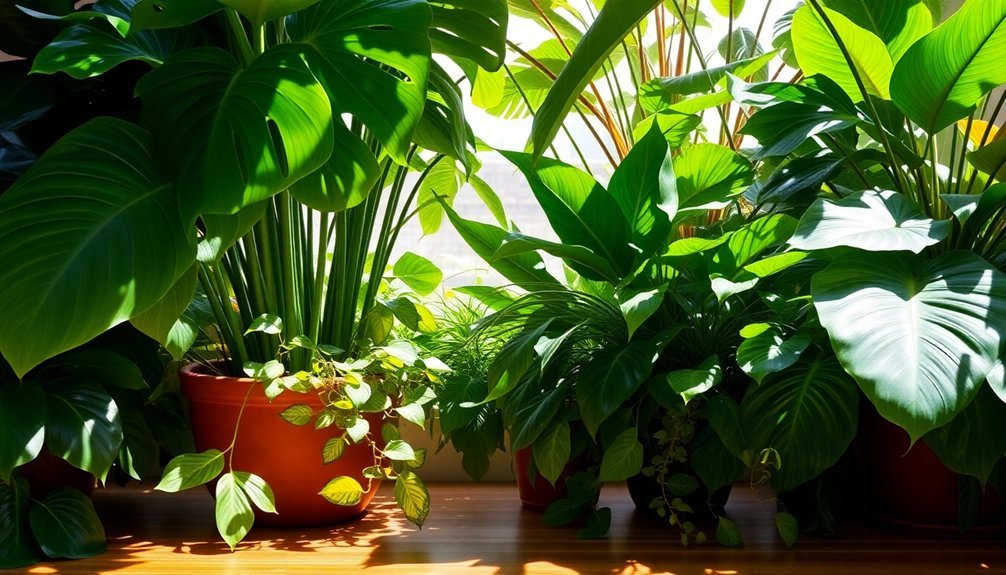
While many people assume outdoor air pollution poses the greatest health risk, the air inside your home can actually be more contaminated with toxic pollutants.
Your indoor air quality is affected by numerous sources, including household cleaning products, mold, pet dander, and secondhand smoke.
The most concerning toxic pollutants you'll find in your home are formaldehyde, benzene, and ammonia.
Formaldehyde can irritate your respiratory system and eyes, potentially leading to chronic health issues.
You'll often encounter benzene in tobacco smoke and various indoor products, which may cause dizziness and severe headaches.
Common cleaning products release ammonia, triggering coughing fits and eye irritation.
Understanding these sources of indoor air pollution is essential, as you're likely exposed to these harmful substances daily without realizing their impact on your health.
Science Behind Plant-Based Air Purification Systems
Your houseplants work as natural air purifiers through phytoremediation, where their leaves and roots actively absorb indoor toxins and convert them into harmless substances.
The efficiency of this process depends largely on the plant's leaf surface area, with broader-leaved tropical varieties like Rubber Plants capturing more airborne pollutants than their smaller counterparts.
You'll get the best results when you understand that plants filter air through tiny pores in their leaves called stomata, which trap harmful chemicals while releasing clean oxygen back into your living space.
Natural Filtration Process Explained
Understanding how tropical plants purify indoor air reveals a fascinating natural filtration process that rivals modern technological solutions.
When you place tropical plants like Bamboo and Areca Palms in your home, they actively work to remove harmful indoor air pollutants through their leaves and root systems.
The natural filtration process is remarkably efficient – plants can reduce up to 95% of certain VOCs within just 24 hours. They absorb toxins like formaldehyde, benzene, and ammonia, converting them into harmless compounds.
The NASA Clean Air Study recommends one plant per 100 square feet for ideal results. You'll get the best results by combining different tropical species, as each excels at purifying the air in unique ways.
Some plants, such as the Peace Lily, offer the added benefit of increasing humidity levels naturally.
Plant Toxin Absorption Mechanisms
Since plants act as nature's own air purification systems, their toxin absorption mechanisms offer a remarkable solution for cleaner indoor environments.
You'll find that tropical plants utilize two primary pathways to remove toxins: their leaves and root systems. Through these pathways, they convert harmful compounds into harmless substances.
When you're looking to improve indoor air quality, understanding how air purifying plants work is essential. Your tropical plants engage in transpiration, releasing water vapor that increases humidity while simultaneously filtering pollutants.
The soil's microorganisms work alongside plant roots to break down toxins continuously. For peak effectiveness, you'll want to combine your plant toxin absorption mechanisms with proper ventilation, as this partnership guarantees ideal air purification.
Common pollutants like formaldehyde, benzene, and ammonia are effectively eliminated through this natural process.
Leaf Surface Area Impact
When exploring the science of plant-based air purification, leaf surface area emerges as a critical factor in toxin removal efficiency.
You'll find that air-purifying plants with broader leaves, like Rubber Plants and Peace Lilies, excel at filtering toxins from the air due to their expansive surface area.
The NASA Clean Air Study confirms that plants with extensive foliage, such as Boston Ferns and Spider Plants, are particularly effective at eliminating common indoor pollutants.
Their larger leaf surfaces enhance photosynthesis, allowing them to convert harmful compounds into harmless substances more efficiently.
To optimize your indoor air quality, you'll want to place one plant per 100 square feet.
Optimal Tropical Plant Groupings for Living Spaces
As you explore ways to purify your home's air naturally, strategic groupings of tropical plants can create powerful air-filtering zones throughout your living spaces.
To maximize air purification, pair complementary species like the Areca Palm with Spider Plants and Peace Lilies, placing one plant per 100 square feet of space.
Position your tropical plants in areas with indirect light to boost their air-cleaning capabilities.
Create visual interest by combining plants of varying heights, such as the towering Rubber Plant with the more compact Boston Fern.
For best results, cluster air-filtering champions like the Bamboo Palm and Ficus Alii together in well-lit corners.
This arrangement not only enhances your home's aesthetic appeal but also establishes efficient toxin-filtering stations that target harmful compounds like benzene and formaldehyde.
High-Performance Palm and Fern Combinations
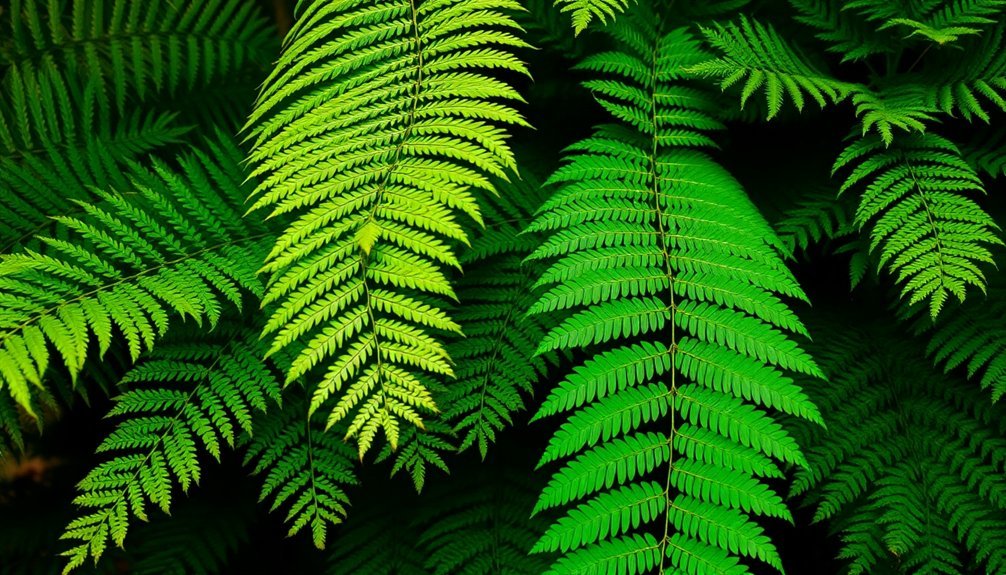
Creating powerful air-cleaning combinations starts with pairing the right palms and ferns together. The high-performance duo of Areca Palm and Boston Fern stands out as an exceptional choice for purifying your indoor air.
While the Areca Palm effectively filters ammonia and regulates humidity, the Boston Fern excels at removing formaldehyde from your space.
You'll find this dynamic pair particularly effective in areas where air quality needs the most attention, like bathrooms and high-humidity spaces. Together, they tackle indoor air pollutants such as xylene while creating a lush, tropical atmosphere.
Moisture-Loving Purifiers for Bathroom Environments
Bathrooms provide the perfect environment for specific tropical plants that excel at air purification. These moisture-loving varieties naturally thrive in high-humidity spaces while removing harmful toxins from your air.
- The Bamboo Palm and Lady Palm eliminate ammonia and formaldehyde from cleaning products, acting as natural humidifiers.
- Peace Lilies flourish in low-light bathroom environments while filtering out benzene and trichloroethylene.
- Boston Ferns and Areca Palms work together to create fresher air by removing multiple toxins.
You'll find these tropical plants particularly effective in bathroom environments because they don't need frequent watering, thanks to the natural moisture present.
Their air purifying abilities work continuously to combat common bathroom pollutants, while their lush appearance transforms your space into a spa-like retreat.
Position them near your shower or tub for ideal humidity exposure.
Low-Light Plant Clusters for Bedroom Air Quality

While bedrooms demand peaceful atmospheres for restful sleep, strategically placed low-light plant clusters can greatly improve your air quality throughout the night.
You'll find that pairing a Snake Plant with a Peace Lily creates a powerful air-purifying duo that thrives in dim conditions while removing common household toxins like benzene and ammonia.
For maximum benefits, combine these with Chinese Evergreen and Pothos in darker corners where other plants might struggle.
These air purifying plants work together to filter harmful chemicals while requiring minimal care.
Add a ZZ Plant to complete your bedroom cluster – it's especially effective at removing toxins like xylene and toluene.
Together, these low-light tolerant species create a natural air filtration system that works while you sleep.
Strategic Placement of Plant Groups for Maximum Effect
Beyond bedroom arrangements, strategic plant groupings throughout your home can dramatically boost air purification and create harmonious living spaces.
You'll maximize your air purifying plants' effectiveness by placing them in zones that match their natural preferences while enhancing your home's air quality.
- Position Areca Palm, Bamboo Palm, and Peace Lily clusters in areas with indirect light to create powerful air-filtering stations.
- Install Boston Ferns and Spider Plants in your bathroom or kitchen to leverage higher humidity levels.
- Mount Pothos and Philodendron groups on elevated surfaces where their trailing vines can efficiently clean the air.
The strategic placement of these plant combinations helps you create a natural filtration system throughout your home.
Remember to group plants with similar care requirements together, ensuring they thrive while working as your home's green air purifiers.
Maintaining Healthy Plant Communities for Long-Term Benefits
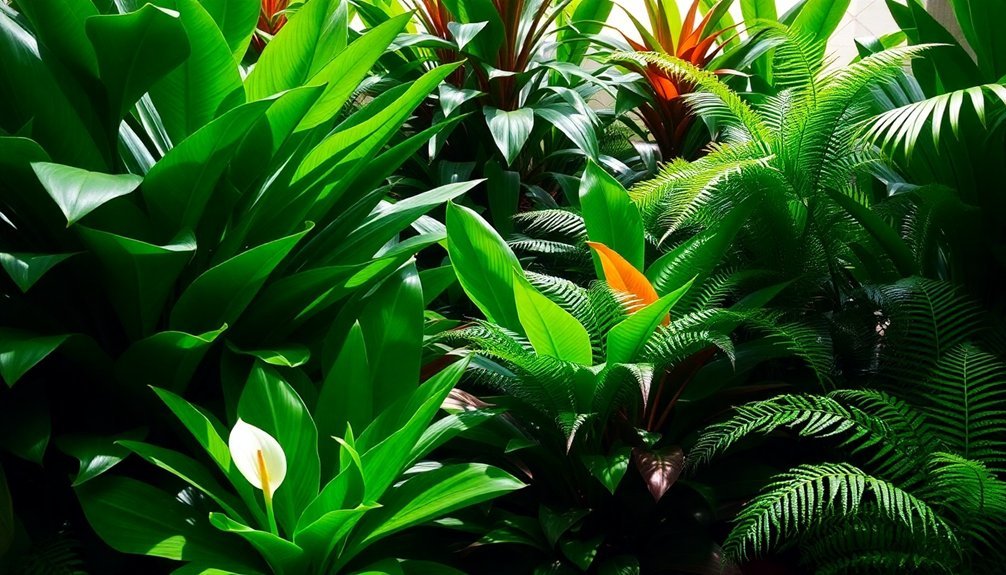
You'll want to space your tropical plants at least 18-24 inches apart to prevent overcrowding and guarantee proper air circulation throughout your indoor garden.
When grouping air-purifying plants like Peace Lilies and Snake Plants together, position taller species toward the back or center of the arrangement while keeping shorter plants along the edges for balanced growth and ideal exposure.
Your plant community will thrive when you regularly monitor each species' growth rate and adjust their positions as needed, preventing aggressive growers from overshadowing their slower-growing neighbors.
Optimal Plant Spacing Rules
The three key principles of ideal plant spacing can make or break your indoor tropical garden's success. For best spacing, you'll want to position your plants 12-24 inches apart, ensuring adequate airflow and light penetration for healthy growth and maximum air purification benefits.
Key spacing considerations for your tropical plants:
- Position larger species like Areca Palms with enough room to reach their mature size.
- Group plants with similar light and water needs to create beneficial microclimates.
- Use decorative stands and varying heights to maximize light exposure.
Balancing Growth Between Species
Creating a thriving indoor tropical garden requires careful consideration of how different plant species interact and grow together. You'll want to focus on maintaining diversity by pairing plants with complementary care needs, like combining Areca and Bamboo Palms that share similar humidity requirements.
To optimize your indoor garden's success, pair fast-growing species with slower ones. For example, combine quick-growing Pothos with Fiddle Leaf Figs to maximize light usage and resource distribution.
When selecting plant companions, consider grouping low-maintenance options like Snake Plants and ZZ Plants, which share similar care routines. Monitor soil moisture carefully, as each species has unique watering needs.
This balanced approach guarantees your tropical plant community thrives while delivering maximum air-purifying benefits to your home.
Frequently Asked Questions
What Plant Removes 78% of Airborne Mold?
The Boston Fern (Nephrolepis exaltata) removes 78% of airborne mold from your home. You'll find it's especially effective in humid spaces like bathrooms and kitchens, where it'll also filter other harmful toxins.
Which House Plant Purifies the Air the Most?
You'll get the most air purification from the Boston Fern, ranking highest in formaldehyde removal. It's especially effective when paired with Peace Lilies, which tackle multiple toxins and act as natural humidifiers.
What Plant Removes the Most Toxins?
You'll find the Peace Lily is your best choice for removing multiple toxins. It effectively eliminates four major pollutants: ammonia, benzene, formaldehyde, and trichloroethylene, making it the most thorough air-purifying plant available.
What Is the Healthiest Plant to Have in Your House?
You'll get the most health benefits from a Snake Plant in your house. It's exceptionally good at purifying air, producing oxygen at night, and removing multiple toxins while requiring minimal care to thrive.
In Summary
You'll achieve the best air-purifying results by grouping 3-5 complementary tropical plants together in high-traffic areas of your home. Remember to rotate your clusters seasonally, ensuring each plant thrives in its ideal light conditions. Maintain your green air filters by dusting leaves weekly and monitoring soil moisture. With proper care, your tropical plant clusters will continuously cleanse your indoor air and enhance your living space.

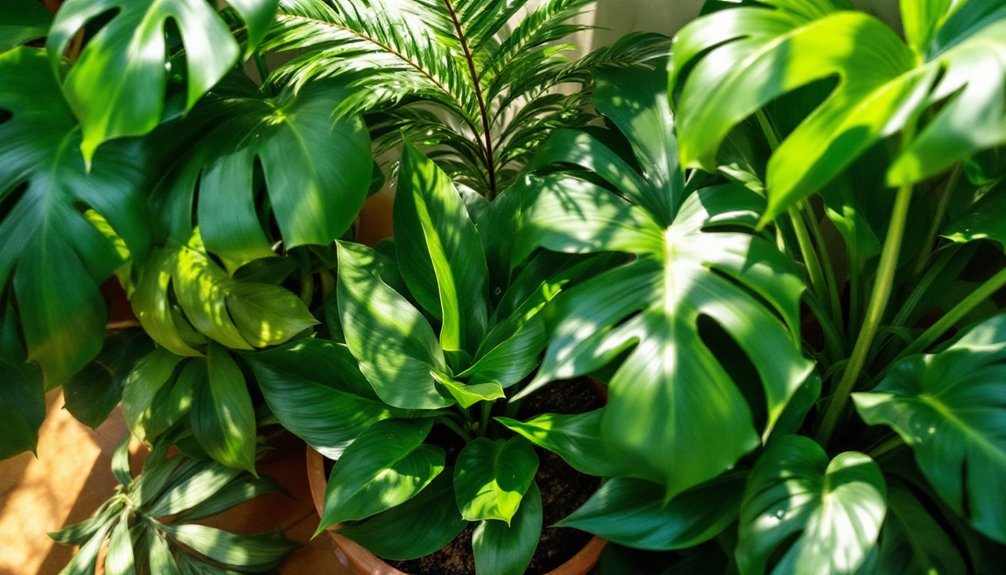


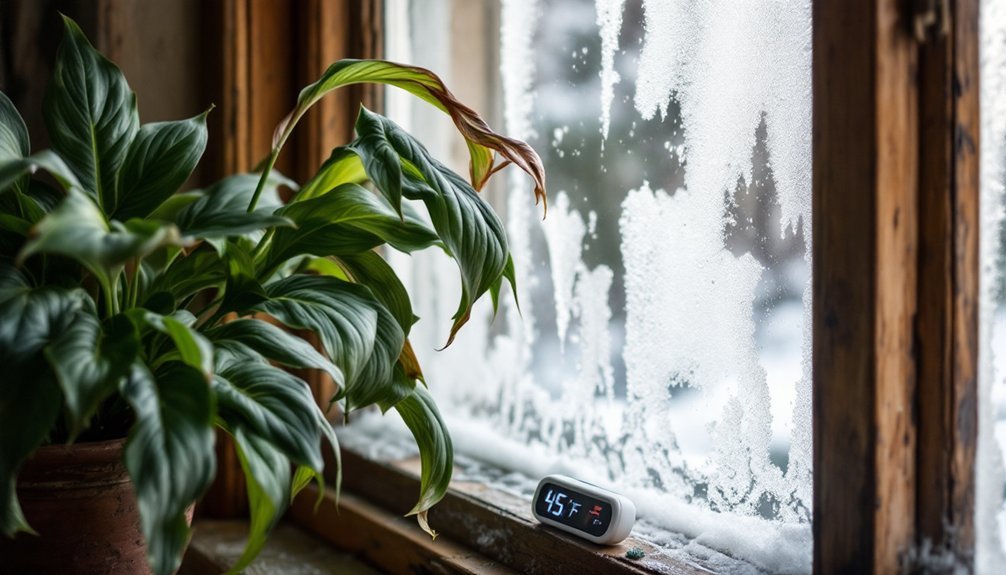
Leave a Reply